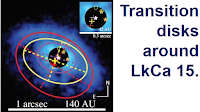The European Space Agency has released a new image of the Beta Pictoris, as seen by the James Webb Space Telescope, in a press release issued on 10 January 2024. The image shows the two main debris disks of the system, which are offset from one another by about 5°, as well as a new and previously unseen feature, which has been named the 'Cat's Tail'.
Debris disks are rings of dust, rock and icy material left surrounding stars after planet formation has occurred (unlike protoplanetary disks, which are present around very young stars only, and which are thought to be largely consumed by planetary formation). Our Solar System has two such debris disks, the Asteroid Belt and the Kuiper Belt, and in recent years improved telescope technology has allowed astronomers to detect debris disks around about 80 of other stars. Most of these disks have been detected only at infrared wavelengths; imaging disks at visual wavelengths enables astronomers to study the morphology and composition of such disks in far greater detail, enabling them to predict the presence of planets that cannot be directly detected and better understand planetary formation around other stars.
Beta Pictoris is a young star 62.4 light years from Earth in the constellation Pictor. Although it is thought to be only 20-25 million years old, it is 1.75 times as massive as the Sun, and therefore 8.7 times as luminous.
The main debris disk of Beta Pictoris was discovered in 1983 by the Infrared Astronomical Satellite, one of the first extra-Solar debris disks ever discovered. This disk is seen edge-on from the Earth, and extends about 1835 from the star (i.e 1835 times as far from the star as the Earth is from the Sun), with the northeast arm rotating towards us and the southwest arm rotating away.
In 2006 the Hubble Space Telescope discovered as much fainter secondary debris disk around Beta Pictoris, offset by about 5° from the main disk. This secondary disk extends about 130 AU from the star, and is thought to be caused by a massive planet deflecting material from the main disk onto an orbit aligned with its own.
The precise nature of the Cat's Tail is unclear, but in 2014 the Atacama Large Millimeter/submillimeter Array detected a clump of carbon monoxide at a similar location. The high levels of radiation emitted by the star should break down carbon monoxide quite quickly, suggesting that the gas was a result of a recent event. The Cat's Tail is thought to be comprised of dusty material, with an equivalent mass similar to that of a large body in the Main Asteroid Belt of our Solar System, spread our over a distance of about 16 billion km (107 AU). This is probably only offset from the main debris disk by about 5°, but appears curved because of the rotation of the system. It is likely that the dust of the Cat's Tail and the carbon monoxide clump detected by the Atacama Large Millimeter/submillimeter Array are the result of a single, catastrophic event.
See also...









.png)